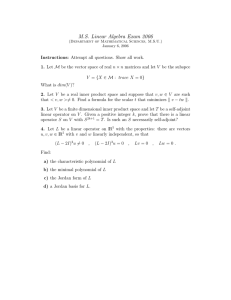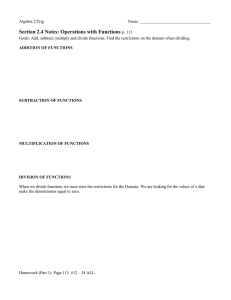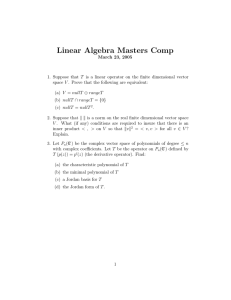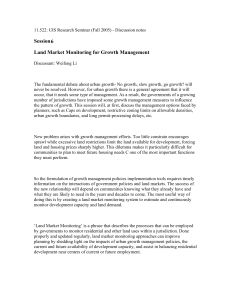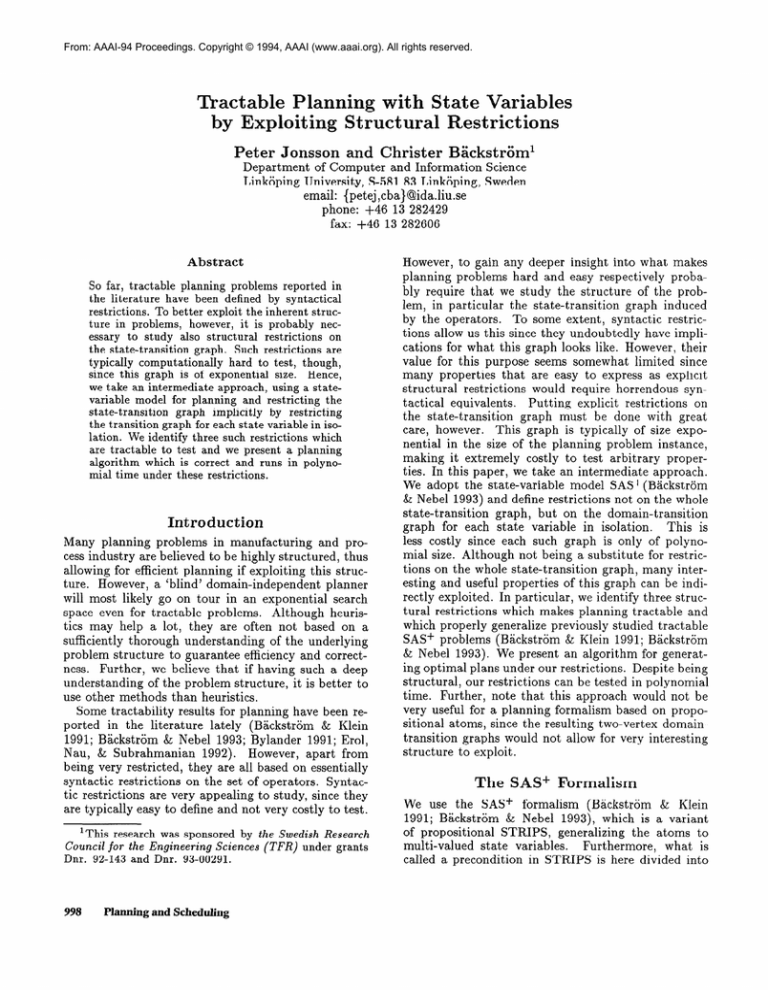
From: AAAI-94 Proceedings. Copyright © 1994, AAAI (www.aaai.org). All rights reserved.
Tractable Planning with State Variables
by Exploiting Structural Restrictions
Peter Jonsson
and Christer
BGckstr6m’
Department
of Computer
and Information
Linkijping University, S-581 83 Link&ping,
email: {petej,cba)@ida.liu.se
phone: +46 13 282429
fax: +46 13 282606
Abstract
So far, tractable planning problems reported in
the literature have been defined by syntactical
restrictions. To better exploit the inherent structure in problems, however, it is probably necessary to study also structural restrictions on
the state-transition graph. Such restrictions are
typically computationally hard to test, though,
since this graph is of exponential size. Hence,
we take an intermediate approach, using a statevariable model for planning and restricting the
state-transition
graph implicitly by restricting
the transition graph for each state variable in isolation. We identify three such restrictions which
are tractable to test and we present a planning
algorithm which is correct and runs in polynomial time under these restrictions.
Introduction
Many planning
problems
in manufacturing
and process industry are believed to be highly structured,
thus
allowing for efficient planning
if exploiting
this structure. However, a ‘blind’ domain-independent
planner
will most likely go on tour in an exponential
search
space even for tractable
problems.
Although
heuristics may help a lot, they are often not based on a
sufficiently thorough understanding
of the underlying
problem structure
to guarantee efficiency and correctness. Further, we believe that if having such a deep
understanding
of the problem structure,
it is better to
use other methods than heuristics.
Some tractability
results for planning have been reported in the literature
lately (Backstrom
& Klein
1991; Backstrom
& Nebel 1993; Bylander
1991; Erol,
Nau, & Subrahmanian
1992).
However, apart from
being very restricted,
they are all based on essentially
syntactic restrictions
on the set of operators.
Syntactic restrictions are very appealing
to study, since they
are typically easy to define and not very costly to test.
‘This research was sponsored by the Swedish Research
for the Engineering
Sciences
(TFR)
under grants
Dnr. 92-143 and Dnr. 93-00291.
Council
998
Planning and Scheduling
Science
Sweden
However, to gain any deeper insight into what makes
planning
problems hard and easy respectively
probably require that we study the structure
of the problem, in particular
the state-transition
graph induced
by the operators.
To some extent, syntactic
restrictions allow us this since they undoubtedly
have implications for what this graph looks like. However, their
value for this purpose seems somewhat
limited since
many properties
that are easy to express as explicit
structural
restrictions
would require horrendous syntactical equivalents.
Putting
explicit restrictions
on
the state-transition
graph must be done with great
care, however.
This graph is typically of size exponential in the size of the planning problem instance,
making it extremely
costly to test arbitrary
properties. In this paper, we take an intermediate
approach.
We adopt the state-variable
model SAS+(Backstrom
& Nebel 1993) and define restrictions
not on the whole
state-transition
graph, but on the domain-transition
graph for each state variable in isolation.
This is
less costly since each such graph is only of polynomial size. Although not being a substitute
for restrictions on the whole state-transition
graph, many interesting and useful properties of this graph can be indirectly exploited.
In particular,
we identify three structural restrictions
which makes planning tractable
and
which properly generalize previously studied tractable
SAS+ problems (Backstrom
& Klein 1991; Backstrom
& Nebel 1993). We present an algorithm for generating optimal plans under our restrictions.
Despite being
structural,
our restrictions
can be tested in polynomial
time. Further, note that this approach would not be
very useful for a planning formalism based on propositional atoms, since the resulting two-vertex domaintransition
graphs would not allow for very interesting
structure
to exploit.
The SAS+
Formalism
We use the SAS+ formalism
(Backstrom
& Klein
1991; Backstrom
& Nebel 1993), which is a variant
of propositional
STRIPS,
generalizing
the atoms to
multi-valued
state variables.
Furthermore,
what is
called a precondition
in STRIPS is here divided into
two conditions,
the precondition
and the prevailcondition.
Variables
which are required
and changed
by an operator
go into the precondition
and those
which remain unchanged,
but are required,
go into
We briefly recapitulate
the
the prevailcondition.
SAS+ formalism
below, referring to Backstrom
and
Nebel (Backstrom
& Nebel 1993) for further explanation. We follow their presentation,
except for replacing
the variable indices by variables and some other minor
changes.
Definition 1 An instance
of the SAP
planning problem is given by a tuple II = (Y, 0, SO, s*) with components defined as follows:
v= {Vl,...,
urn} is a set of state variables. Each
variable v E V has an associated
domain 2),, which
implicitly
defines an extended domain V$ = V, U
{u}, where u denotes
the undefined value.
Further, the total state space S = ‘D,,, x . . . x VV,
and the partial state space S+ = DV+ x . . . x DV+,
We write s[v] to denote the
are implicitly
defined.
value of the variable v in a state s.
0
is a set of operators
of the form (b, e, f), where
E S+ denote
the pre-, post- and prevailcondition
respectively.
If o = (b, e,f) is a SAP
operator,
we write b(o), e(o) and f(o) to denote b, e
and f respectively.
0 is subject to the following
two
restrictions
b, e,f
(Rl)
for
all o E 0
and v E V if b(o)[v]
# u, then
Wvl # 44bA # UT
(y))fir-all
0 v -u.
o E 0
and
v E V,
e(o)[v]
=
u or
To define partially
ordered plans, we must introduce the concept of actions, ie. instances of operators.
Given an action a, type(u) denotes the operator that
a instantiates.
Furthermore,
given a set of actions Yq,
we define type(A) = {type(u)
1 a E A} and given a sequence cy = (al,. . . , a,) of actions, type(a) denotes the
operator sequence (type(ul),
. . . , type(u,)).
Definition 2 A partial-order
plan is a tuple (/I, -i)
instances
of opwhere A is a set of actions,
ie.
A
order on 4.
erat ors, and + is a strict partial
instance
II ifl
partial-order
plan (/I, 4) solves a SAP
solves II for each topological
(tYP+l),
* * *j tYP+n>>
sort (al,...,
%> of (A, -+
Further, given a set of actions A over 0, and a variable v E V, we define J~[v] = {a E A ] e(u)[v] # u}, ie.
the set of all actions in A affecting v.
Structural
Restrictions
In this section we will define three structural
restrictions (I, A and 0) on the state-transition
graph, or,
rather, on the domain-transition
graphs for each state
variable in isolation.
We must first define some other
concepts, however. Most of these concepts are straightforward, possibly excepting the set of requestable
values, which plays an important
role for the planning
algorithm in the following section. Unary operators is
one of the restrictions
considered
by Backstrom
and
Nebel (1993), but the others are believed novel. For
the definitions below, let II = (V, 0, so, se) be a SAS+
instance.
state
and
Definition 3 An operator o E 0 is unary
exactly one v E V s-t. e(o)[v] # u.
We write s C t if the state s is subsumed _(or
_
zsfied) by state t, ie. if s[v] = u or s[v] = t[v].
extend this notion to whole states, defining
satWe
A value x E /D, where x # u for some variable v E
Y is said to be requestable
if there exists some action
o E 0 such that o needs x in order to be executed.
so E s+ and s* E S+ denote
goal state respectively.
the initial
s E t iff for all v E Y, s[v] = u or s[v] = t[v].
Seqs(O)
denotes the set of operator
sequences
over 0
and the members
of Seqs(0)
are called plans. Given
two states s, t E S+, we define for all v E V,
if +I Yfu>
otherwzse.
The ternary
relation
Valid C Seqs(O)
x S+ x S+ is
defined recursively
s.t. for arbitrary
operator
sequence
and arbitrary
states s, t E Sf,
E Seas(o)
(01,.
* *, on)
Valid((ol,
. . . , on), s, t) ifl either
I.
n = 0 and t C s or
2. n > 0, b(ol) C s, f(o1) C s and
Valid((o2, . . . , 4,
(s @ e(ol>>, t>Finally,
Valid((ol,
a plan (01, . . . , on) E Seqs(0)
. . . , o,), so, s*).
2Drummond
solves II i#
& Currie (1988) make the same distinction.
i# there
is
Definition 4 For each v E V and 0 E 0, the set 72:’
of requestable
values for 0’ is defined as
Ry
=
(f(o)[v]
1 o E 0’)
{b(o)[v],e(o)[v]
u
1 o E 0’ and
o non-unary}
-+JlSimilarly,
for
R$t = ~y44.
a set A
of actions
over
0,
we define
Obviously,
72: c VD, for all v E V. For each state
variable domain, we further define the graph of possible
transitions
for this domain, without taking the other
domains into account, and the reachability
graph for
arbitrary
subsets of the domain.
Definition 5 For
sponding domain
labelled graph G,
arc set I, s.t. for
7, ifl b(o)[v]
= x
each v E V, we define the corretransition graph G, as a directed
= (V$, TV) with vertex set V$ and
all x, y E V$ and o E 0, (x, o, y) E
and e(o)[v] = y # u. Further,
for
Causal-Link
Phqing
999
each X E lJ$ we define the reachability
graph for
X as a directed graph Gc = (X,7x)
with vertex set
X and arc set TX s.t. for all x, y E X, (x, y) E TX ifl
there is a path from x to y in G,.
Alternatively,
Gc can be viewed as the restriction
to
XcD,+ofth
e t ransitive closure of G,, but with unlabelled arcs. When speaking about a path in a domaintransition
graph below, we will typically mean the sequence of labels, ie. operators, along this path. We say
that a path in G, is via a set X C D, iff each member
of X is visited along the path, possibly as the initial
or final vertex.
Definition 6 An operator
o E 0 is irreplaceable
wrt. a variable v E V ifl removing
an arc labelled with
o from G, splits some component
of G, into two components.
In the remainder
of this paper we will be primarily
interested
in SAS+ instances satisfying
the following
restrictions.
Definition
7 A SAP
instance
(V, 0, SO, s*)
(I) Interference-safe
ifl every operator
ther unary or irreplaceable
wrt. every
fects.
(A)
Acyclic
a” GTF is acyclic
for
is:
0 E 0 is eiv E V it afi
each v E V.
(0) prevail-Order-preserving
ijg for each v E V,
whenever
there are two x, y E lJ$ s.t.
G, has a
shortest path (01, . . . , om) from x to y via some set
X s 72: and it has any path (0’1,. . . ,oL) from x to y
via some set Y c 72: s.t. X E Y, there exists some
subsequence
(. . . , oil,. . . , o{,, . . .) s.t. f(ok) -C f(oi,)
for 1 5 k 5 m.
We will be mainly concerned with SAS+-IA and SAS+IA0 instances,
that is, SAS+ instances satisfying the
two restrictions
I and A and SAS+ instances satisfying
all three restrictions
respectively.
Both restrictions
I
and A are tractable
to test. The complexity
of testing 0 in isolation is currently
an open issue, but the
combinations
IA and IA0 are tractable to test.
Theorem 8 The restrictions
I and A can be tested
in polynomial
time for arbitrary
SApinstances.
Restriction
0 can be tested in polynomial
time for SAe
instances
satisfying
restriction
A.
Proof sketch: 3 Testing A is trivially
a polynomial
time problem. Finding the irreplaceable
operators wrt.
a variable v E V can be done in polynomial
time by
identifying
the maximal
strongly
connected
components in G, , collapsing each of these into a single vertex
and perform a reachability
analysis. Since it is further
polynomial
to test whether an operator is unary, it follows that also I can be tested in polynomial
time.
Furthermore,
given that the instance satisfies A, 0
can be tested in polynomial
time as follows. For each
3The full proofs of all theorems can be found in (Jonsson
& B&ckstGm 1994).
Planning and Scheduling
pair of vertices x, y E D$, find a shortest path in G,
from x to y. If the instance satisfies 0, then for each
operator o along this path, 2): can be partitioned
into
two disjoint sets X, Y s.t. every arc from some vertex
in X to some vertex in Y is labelled by an operator o’
satisfying that f(o) 5 f(o'). This can be tested in polynomial time by a method similar to finding shortestpaths in G,. Hence, 0 can be tested in polynomial
cl
time if A holds.
Furthermore,
the SAS+-IA0
problem
is strictly
more general than the SAS+-PUS problem (Backstrom
& Nebel 1993).
Theorem 9 All SAP-PUS
instances,
while a SAP-IA0
either P, U or S.
Planning
instances
instance
are SAP-IA0
need not satisfy
Algorithm
Before describing
the actual planning
make the following observations
about
arbitrary
SAS+ instances.
algorithm,
the solutions
we
to
Theorem 10 Let (A, 4) be a partial-order
plan solving some SA,.? instance
II = (V, 0, SO, s*).
Then for
each v E V and for each action sequence
a which is a
total ordering
of A[v] consistent
with 4, the operator
sequence
type(a)
is a path in G, from so[v] to s*[vJ via
R$.
This is a declarative
characterization
of the solutions and it cannot be immediately
cast in procedural
terms-the
main reason being that we cannot know
the sets R$ in advance.
These sets must, hence, be
computed
incrementally,
which can be done in polynomial time under the restrictions
I and A. We have
devised an algorithm,
Plan (Figure l), which serves as
a plan generation
algorithm under these restrictions.
The heart of the algorithm is the procedure Extend,
which operates on the global variables X1, . . . , X,, extending these monotonically.
It also returns operator
sequences in the global variables ~1, . . . , w,, but only
their value after the last call are used by Plan.
For
each i, Extend first finds a shortest path wi in G,,
from sc[vi] to s*[vi] via Xi. (The empty path () is considered as the shortest path from any vertex x to u,
since u 5 x). If no such path exists, then Extend fails
and otherwise each Xi is set to Rf,‘, where 0’ is the
set of all operators
along the paths wi, . . . , w,.
The
motivation
for this is as follows: If f (o)[vi] = x # u
for some i and some operator o in some wj , then some
action in the final plan must achieve this value, unless
it holds initially.
Hence, x is added to Xi to ensure
that Extend will find a path via x in the next iteration. Similarly, each non-unary
operator occurring in
some wi must also appear in wj for all other j such
that o affects v~j.
Starting
with all Xl,. . . , Xm initially empty, Plan
calls Extend repeatedly
until nothing more is added to
these sets or Extend fails. Viewing Extend as a function Extend : S+ + S+, ie. ignoring the side effect on
1
2
3
4
5
6
7
8
9
10
11
12
13
14
1.5
16
17
1
procedure
HCHI((V, 0, SO,s*));
(Xl,...
, Xm) + (0, - * *, 0);
repeat
sure -@ of 4 since this is a costly
transitive
Extend;
Instantiate;
for 1 5 i 5 m and a, b E cy1: do
Order a 4 b iff a precedes b in CY;;
for 1 _< i 5 m and a E A s.t. f(a)[vi] # u do
a; = (al,.
. . , ak)
Extenc&
(Modifies
Xl,...,Xm
and
- * f Wm)
gi.1 <i-Cm
do
wt L any shortest path from s~[TJ;]to s,[v,] in G,
via Xi;
if no such path exists then fail;
for l<i,j<mandoEw,
do
xi - xi u {f(O)[Vi]} - {u};
if o not unary then
X + Xi u {b(o)[vi], e(o)[vi]} - {u};
procedure
Instantiate;
for 1 2 i 5 m do
Assume
wi = (01,.
(Modifies
(~1, . . . , cym)
. . , ok)
for 1 5 I< k do
if 01 not unary and there is some a of type 01
in cy3for some j < i then al c a;
else Let UEbe a new instance of type(ul);
at
+
(al,.
. . , ak)
Figure
1: Planning
Algorithm
this process corresponds
to constructing
fixed point for Extend in S+. The paths
found in the last iteration
contain all the
Wl,*-*,wm
operators necessary in the final solution and procedure
Instantiate
instantiates
these as actions.
This works
such that all occurrences
of a non-unary
operator are
merged into one unique instance while all occurrences
of a unary operator are made into distinct instances.
It remains to compute the action ordering on the set
A of all such operator instances (actions).
For each vi,
the total order implicit in the operator sequence wi is
kept as a total ordering on the corresponding
actions.
Finally, each action a s.t. f (a)[vi] = x # u for some
i must be ordered after some action a’ providing this
condition. There turns out to always be a unique such
action, or none if vi = x initially. Similarly, a must be
ordered before the first action succeeding
u’ that destroys its prevailcondition.
Finally, if + is acyclic, then
(A, 4) is returned
and otherwise Plan fails. Observe
that the algorithm does not compute the transitive cloWl, * - * ,wm,
the minimal
for ex-
and
in-
Theorem
11 If Plan returns
a plan (A, 4) when
given a SAL?-IA
instance
l-I as input, then (A, 4)
solves rl[ and if II is a SAP-TAO
instance,
then (A, 4)
is also minimal.
Further,
if Plan fails when given a
SAP-IA0
instance
n as input, then there exists no
plan solving rI.
if e(al)[v;] = f(a)[v;] for some 1 5 I 5 Ic then
Order al 4 a;
if 1 < Ic then Order a + al+l;
else Order a 4 al;
A + {a E (Y; 115 i 5 m);
if -i is acyclic then return (A, 4);
else fail;
procedure
and the
ecuting the plan.
Procedure Plan is sound for SAS+-IA instances
it is further optimal and complete for SAS+-IA0
stances.
until no Xi is changed;
Assume
operation
closure is not likely to be of interest
The proofs for this theorem are quite
Proof outline:
long, but are essentially based on the following observations. Soundness is rather straightforward
from the
algorithm and Theorem 10. Further, let (A,+) be the
plan returned by Plan and let (A’, 4) be an arbitrary
solution to II. Minimality
follows from observing that
Ri E %?f’ for all v E V. The completeness
proof essentially builds on minimality
and proving that if -+
contains a cycle (ie. Plan fails in line 16)) then there
0
can exist no solution to II.
Furthermore,
Plan
returns
LC2-minimal
plans
(Backstriim
1993) which means that there does not
exist any strict (ie. irreflexive) partial order 4’ on A
such that 1 4 1 < 1 -@ 1 and (A, 4) is a valid plan.
Finally, Plan runs in polynomial
time.
Theorem
12 Plan
has
a worst-case
of ow12v4 mmEv1%1>3>.
time
complexity
Example
In this section, we will present a small, somewhat contrived example of a manufacturing
workshop and show
how the algorithm
handles this example.
We assume
that there is a supply of rough workpieces and a table for putting finished products.
There are also two
workstations:
a lathe and a drill. To simplify matters,
we will consider only one single workpiece.
Two different shapes can be made in the lathe and one type
of hole can be drilled.
Furthermore,
only workpieces
of shape 2 fit in the drill. This gives a total of four
possible combinations
for the end product:
rough (ie.
not worked on), shape 1, shape 2 without a hole and
shape 2 with a hole. Note also that operator Shape2 is
tougher to the cutting tool than Shape1 is-the
latter
allowing us to continue using the cutting tool afterwards.
Finally, both the lathe and the drill require
that the power is on. This is all modelled by five state
variables, as shown in Table 1, and nine operators,
as
shown in Table 2. This example is a SAS+-IA0
instance, but it does not satisfy either of the P, U and S
restrictions
in B&zkstrijm and Nebel ( 1993).4
4Note in particular that since we do no longer require
the S restriction, we can model sequences of workstations, which was not possible under the PUS restriction
(B%ckstrGm & Klein 1991).
Causal-Link
Planning
1001
variable
1
2
3
4
5
domain
{ Supply,Lathe,Drill,Table}
{Rough,W)
[:inkUrd}
{Y:::N:]
Table
Table 2: Operators
only).
1: State variables
Operator
MvSL
MvLT
MvLD
MvDT
Shape1
Shape2
Drill
Pon
Poff
Precondition
for the workshop
example.
01
=s
211= L
Vl =L
Vl = D
212 =R
v2 = R, v3 = M
V4 =N
v5 =N
v5 =Y
denotes
Position of workpiece
Workpiece shape
Condition of cutting tool
Hole in workpiece
Power on
for the workshop
Postcondition
211= L
W =T
Vl =D
VI = T
v2 = 1
v2 = 2, v3 = u
v4 = Y
05 =Y
vi = N
(Domain
After iteration 1:
example
Prevailcondition
v2 = 2
VI = L, v3 = M, v5 = Y
Vl = L,?& = Y
v1=D,v5=Y
values will typically
be denoted
by their initial
characters
Similarly,
Drill must be ordered between MvLD and
MvDT because of its prevailcondition
on variable 1 and
both Shape2 and Drill must be ordered between Pon
and Poff because of their prevailcondition
on variable
5. Furthermore,
MvLD must (once again) be ordered
after Shape2 because of its prevailcondition
on variable
2. The final partial-order
plan is shown in Figure 2.
After iteration 2:
Discussion
~~
Table 3: The variables
wi and Xi in the example.
Suppose we start in SO = (S, R, A8, N, N) and set the
goal s* = (T, 2, u, Y, IV), that is, we want to manufacture a product of shape 2 with a drilled hole. We also
know that the cutting tool for the lathe is initially in
mint condition, but we do not care about its condition
after finishing.
Finally, the power is initially off and
we are required to switch it off again before leaving
Plan will make two calls to
the workshop.
Procedure
Extend before terminating
the loop successfully,
with
variable values as in Table 3.
The operators in the operator sequences ~1, . . . , w5
will be instantiated
to actions, where both occurrences
of Shape2 are instantiated
as the same action, since
Shape2 is non-unary.
Since there is not more than one
action of each type in this plan, we will use the name
of the operators
also as names of the actions.
The
total orders in ~1,. . . ,wm is retained in al,. . . , Q,.
Furthermore,
Shape2 must be ordered after MvSL and
before MvLD, since its prevailcondition
on variable 1
equals the postcondition
of MvLD for this variable.
1002
Planning and Scheduling
Several attempts
on exploiting
structural
properties
on planning problems in order to decrease complexity
have been reported in the literature,
but none with the
aim of obtaining
polynomial-time
planning
problems.
Korf (1987) has defined some structural
properties of
planning problems modelled by state-variables,
for instance serial operator decomposability.
However, this
property is PSPACE-complete
to test (Bylander 1992),
but does not guarantee
tractable
planning.
Madler
(1992) extends Sacerdoti’s
(1974) essentially
syntactic state abstraction
technique
to structuruE abstraction, identifying
bottle-neck
states (needle’s
eyes) in
the state-transition
graph for a state-variable
formalism. Smith and Peot (1993) use an operator graph for
preprocessing
planning
problem instances,
identifying
potential
threats that can be safely postponed
during
planning-thus,
pruning the search tree. The operator graph can be viewed as an abstraction
of the full
state-transition
graph, containing
all the information
relevant to analysing threats.
A number of issues are on our research agenda for
the future.
Firstly, we should perform a more careful
analysis of the algorithm to find a tighter upper bound
for the time complexity.
Furthermore,
the fixpoint for
the Extend function is now computed by Jacobi iteration, which is very inefficient.
Replacing this by some
strategy for chaotic iteration (Cousot & Cousot 1977)
MvDT
Poff
Figure
2: The final partial-order
would probably improve the complexity
considerably,
at least in the average case. Furthermore,
the algorithm is likely to be sound and complete for less restricted problems than SAS+-IA and SAS+-IA0
respectively.
Finding restrictions
that more tightly reflect the limits of the algorithm is an issue for future
research.
We also plan to investigate
some modifications of the algorithm,
eg., letting the sets Xi,. . .,X,
be partially ordered multisets, allowing a prevailcondition to be produced and destroyed several times-thus
relaxing the A restriction.
Another interesting
modification would be to relax some of the restrictions
and
redefine Extend as a non-deterministic
procedure.
Although requiring search and, thus, probably sacrificing
tractability,
we believe this to be an intriguing
alternative to ordinary search-based
planning.
Conclusions
We have identified
a set of restrictions
allowing for
the generation
of optimal plans in polynomial
time
for a planning
formalism,
SAS+, using multi-valued
state variables.
This extends the tractability
borderline for planning,
by allowing for more general problems than previously
reported in the literature
to be
solved tractably.
In contrast to most restrictions
in the
literature,
ours are structural
restrictions.
However,
they are restrictions
on the transition
graph for each
state variable in isolation,
rather than for the whole
state space, so they can be tested in polynomial
time.
We have also presented a provably correct, polynomial
time algorithm for planning under these restrictions.
plan.
thought.
Current
ropean
In Backstrom,
C., and Sandewall,
Trends in AI Planning:
Workshop
on Planning,
Applications.
Bylander,
In Reiter
Vadstena,
E., eds.,
EWSP’93--2nd
Eu-
Frontiers in AI and
Sweden: 10s Press.
T. 1991. Complexity
results for planning.
and Mylopoulos
(1991), 274-279.
Bylander, T.
composability.
1992. Complexity
results for serial deIn AAAI-92 (1992)) 729-734.
Cousot, P., and Cousot, R. 1977. Automatic
synthesis of optimal invariant
assertions:
Mathematical
foundations.
SIGPLAN
Notices 12(8):1-12.
Drummond,
M., and Currie, K. 1988. Exploiting temporal coherence in nonlinear plan construction.
Computational
Intelligence
4(4):341-348.
Special Issue on
Planning.
Erol, K.; Nau, D. S.; and Subrahmanian,
On the complexity
of domain-independent
In AAAI-92 (1992), 381-386.
V. S. 1992.
planning.
Jonsson, P., and Backstrom, C. 1994. Tractable planning with state variables by exploiting structural
restrictions.
Research report, Department
of Computer
and Information
Science, Linkijping University.
Korf, R. E. 1987. Planning
as search: A quantitative
approach.
Artificial
Intelligence
33:65-88.
Madler, F.
In Hendler,
Systems:
ference,
1992. Towards structural
abstraction.
Intelligence
Planning
J., ed., Artificial
Proceedings
163-171.
of the
College
ist
Park,
International
Con-
MD, USA: Morgan
Kaufmann.
R., and Mylopoulos,
J., eds. 1991. Proceedings of the 12th International
Joint
Conference
on
Artificial
Intelligence
(IJCAI-91).
Sydney, Australia:
Reiter,
References
American
Association
Proceedings
on Artificial
for Artificial
of the 10th
Intelligence
Intelligence.
1992.
(US) National
Conference
(AAAI-92),
San Jose, CA,
USA.
Backstrom,
C., and Klein, I.
binary planning
in polynomial
Mylopoulos (199 1)) 268-273.
1991.
time.
Parallel nonIn Reiter and
Backstrom,
C., and Nebel, B. 1993. Complexity
results for SAS+ planning.
In Bajcsy, R., ed., Proceedings of the 13th International
Artificial
Intelligence
(IJCAI-93).
Morgan
Joint
Conference
Chambdry,
on
Morgan
Kaufmann.
Sacerdoti,
abstraction
135.
Smith,
threats
E. D. 1974. Planning
in a hierarchy of
spaces.
Artificial
Intelligence
5(2):115-
D. E., and Peot, M. A.
in partial-order
planning.
1993. Postponing
In Proceedings
of
the 11th (US) National
Conference
on Artificial
Intelligence (AAAI-93),
500-506. Washington
DC, USA:
American
Association
for Artificial
Intelligence.
France:
Kaufmann.
Backstrom,
C. 1993. Finding least constrained
plans
and optimal
parallel executions
is harder than we
Causal-Link
Planning
1003

